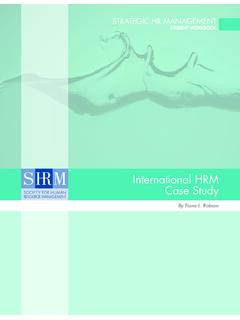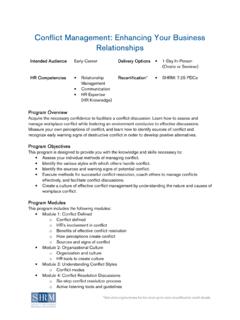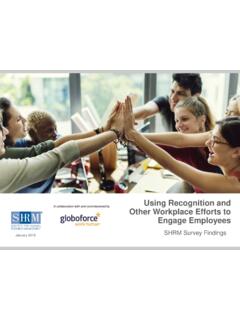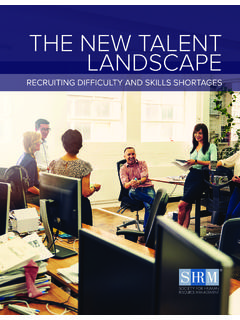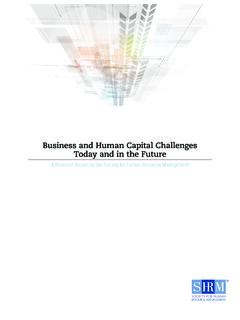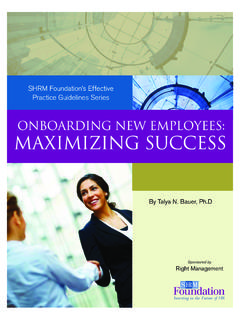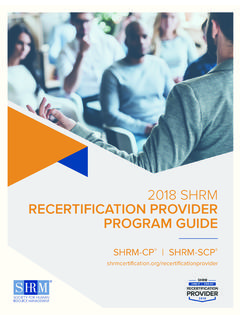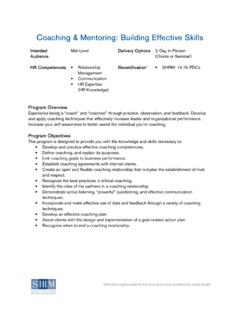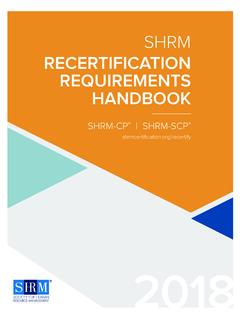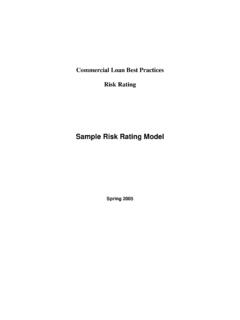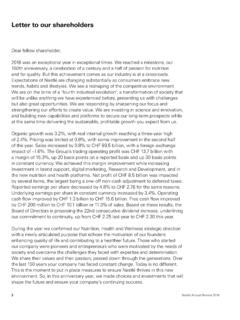Transcription of Developing Leadership Talent - SHRM
1 SHRM Foundation S EFFE ctivE PRacticE GuidElinES SERiESDeveloping Leadership Talent A guide to succession planning And Leadership development by Dav d V. Day, guiDe to succession planning AnD Leadership DeVeloPment SHRM Foundation S EFFE ctivE PRacticE GuidElinES SERiESdeveloping Leadership Talent This publication is designed to provide accurate and authoritative information regarding the subject matter covered. Neither the pub-lisher nor the author is engaged in rendering legal or other professional service. If legal advice or other expert assistance is required, the services of a competent, licensed professional should be sought. Any federal and state laws discussed in this book are subject to frequent revision and interpretation by amendments or judicial revisions that may significantly affect employer or employee rights and obligations.
2 Readers are encouraged to seek legal counsel regarding specific policies and practices in their book is published by the SHRM Foundation, an affiliate of the Society for Human Resource management (SHRM ). The interpretations, conclusions and recommendations in this book are those of the author and do not necessarily represent those of the SHRM Foundation. 2007 SHRM Foundation. All rights reserved. Printed in the United States of publication may not be reproduced, stored in a retrieval system or transmitted in whole or in part, in any form or by any means, electronic, mechanical, photocopying, recording or otherwise, without the prior written permission of the SHRM Foundation, 1800 Duke Street, Alexandria, VA SHRM Foundation is the 501(c)3 nonprofit affiliate of the Society for Human Resource management (SHRM).
3 The SHRM Foundation maximizes the impact of the HR profession on organizational decision-making and performance by promoting innova-tion, education, research and the use of research-based knowledge. The Foundation is governed by a volunteer board of directors, comprising distinguished HR academic and practice leaders. Contributions to the SHRM Foundation are tax deductible. Visit the Foundation online at For more information, contact the SHRM Foundation at (703) 535-6020 LEADERSHIPtalEntdEvEloPinG v Forewordvii Acknowledgmentsix About the Author 1 Developing Leadership Talent 3 Business Case for succession planning and Leadership Development 6 succession management , Not Just Planning18 Leadership Development23 Developmental Practic es31 Conclusion33 References 37 Sources and Suggested Readings contentstable of vDear Colleague:As a busy human resource professional, you probably find it difficult to keep up with the latest academic research in the field.
4 Yet knowing which HR practices have been shown by research to be effective can help you in your role as an HR s why the SHRM Foundation created the Effective Practice Guidelines series. These reports distill the latest research findings and expert opinion into specific advice on how to conduct effective HR practice. Written in a concise, easy-to-read style, these publications provide practical information to help you do your job better. The Effective Practice Guidelines were created in 2004. The SHRM Foundation publishes new reports annually on different HR topics. Past reports, available online at , include Performance management , Selection Assessment Methods, Employee Engagement and Commitment and Implementing Total Rewards Strategies.
5 You are now reading the fifth report in the series, Developing Leadership each report, a subject matter expert with both research and practitioner experience is chosen to be the author. After the initial draft is written, the report is reviewed by a panel of academics and practitioners to ensure that the material is comprehensive and meets the needs of HR practitioners. An annotated bibliography is included with each report as a convenient reference tool. This process ensures that the advice you receive in these reports is not only useful but also based on solid academic research. Our goal with this series is to present relevant research-based knowledge in an easy-to-use format. Our vision for the SHRM Foundation is to maximize the impact of the HR profession on organizational decision-making and performance, by promoting innovation, education, research and the use of research-based knowledge.
6 We are confident that the Effective Practice Guidelines series takes us one step closer to making that vision a reality. Frederick P. Morgeson, , Research Applications CommitteeProfessor of ManagementMichigan State UniversityForewordv Content editorFrederick P. Morgeson, Professor of management Eli Broad College of Business Michigan State UniversityAcknowledgmentsProjeCt ManagerBeth M. McFarland, CAEM anager, Special Projects SHRM FoundationMajor funding for the Effective Practice Guidelines series is provided by the Human Resource Certification Institute (HRCI) and the Society for Human Resource management (SHRM). reviewersBerrin Erdogan, Professor of ManagementSchool of Business AdministrationPortland State UniversityMark Fogel Corporate Vice President, HR and Customer CareLeviton Manufacturing Co.
7 , J. Greene, , SPHR, CCP, CBP, GRP, GPHRC hief Executive Officer Reward $ystems, K. Hite Strategic Director, Human Resources & Organizational DevelopmentYMCA of the USAR obert C. Liden, of ManagementUniversity of Illinois at ChicagoDaphne LoganVice President, Human ResourcesAmerica s Second HarvestThe SHRM Foundation is grateful for the assistance of the following individuals in producing this report: xAbout the AuthorDavid V. Day David V. Day is Professor of Organisational Behaviour in the Lee Kong Chian School of Business, Singapore management University. He has also held positions as Adjunct Research Scientist for the Center for Creative Leadership and Senior Research Fellow for the Army Research Institute Consortium of Research Day has published more than 50 journal articles and book chapters, many pertaining to the core topics of Leadership and Leadership development.
8 His research has been published in the Journal of Applied Psychology, Personnel Psychology, Academy of management Journal, Journal of management and Leadership Quarterly, among other journals. Dr. Day serves on the editorial boards of Human Performance, Journal of Applied Psychology, Journal of management and Personnel Psychology and also serves as Associate Editor of Leadership Quarterly and Human Resource management Review. He is a Fellow of the American Psychological Association and the Society for Industrial and Organizational Psychology. Dr. Day maintains membership in the Academy of management , Asia Academy of management , Southern management Association and the International Association of Applied Day is the lead editor on the book Leader Development for Transforming Organizations: Growing Leaders for Tomorrow (Lawrence Erlbaum Associates, 2004) and the forthcoming book An Integrative Theory of Leader Development: Connecting Adult Development, Identity and Expertise (Psychology Press, 2008).
9 He served as a civilian member of the Army Training and Leader Development Panels recommending future directions for officer, non-commissioned officer and Army civilian training and development. Dr. Day received his in industrial and organizational psychology from the University of Akron in succession planning involves more than just a replacement planning process. It also includes a comprehensive employee development advertising campaign a few years ago promised no surprises in a hotel chain s hospitality services. That is a motto that most HR professionals would embrace. Unfortunately, surprises are inevitable. When a key employee announces that she is leaving the organization, effective immediately, it could be one of those nasty surprises that create incredible turmoil.
10 Not only was this person anointed as high potential ( , having the potential to be developed for a senior Leadership role) and slotted for a more responsible upper-level position, her departure can create a domino-like effect that leaves Leadership gaps all along that succession line. Despite the inevitability of surprises, what matters most is how the HR function is prepared to respond in such foundation for coping successfully with staffing surprises is succession planning . Organizational survival in a globally competitive environment depends in part on having identified and developed replacements ( , successors) for key positions.[1] This is the essence of succession planning . A more formal definition of succession planning is the process of identifying one or more successors for key positions and preparing them for expanded organizational responsibilities through job assignments and other developmental activities.
